Build Log: Part 3
Okay, been working a bit on the arboretum and the shuttle bay walls, mostly just attaching photo-etch pieces, so I’ll do a bit of info on how to make those work a little better.
Handling Photo-Etch
If you haven’t read my frustrations with PE parts in my E25 build log, maybe that’s a good thing :). The PE for the Enterprise is a bit larger and easier to handle, but it’s still a very thin brass sheet and easily bent the wrong way. So let’s go over some basics here.
#1 – Photo etch will bend and crease if you look at it funny. So always, be careful – it’s better to go over the cut several times with a gentle pressure than to do it just once with a lot of pressure.
#2 – Put something strong and un-giving as a surface behind it. I use a glossy white tile that I bought from a DIY warehouse store for something like a buck and a half. It cleans easy, very little sticks to it, and the white surface provides very good contrast when I’m searching for tiny parts.
#3 – the gentle hand is what wins here. If you feel like you’re applying a lot of pressure or you’re straining to cut something, stop and back off. Try something different. When you are applying too much pressure, you are setting yourself up for something bad to happen. Like a trip to the Emergency Room after the part does cut clean and all that extra pressure rams the knife two or three centimeters through your hand.
So – first, find the part on the brass sheet that you need to cut. If there are symmetrical pieces for multiple sides of a model, DO NOT immediately separate them all. They might be different from one another, and this can result in messy removal and reapplication of parts. So – find the part you want, and only cut off that part. If there are multiples and they are identical, then feel free to do more than one at a time. Just make sure they are, indeed, identical.
Next, cut the part free. If you can fit them in, use your snippers. If you can’t, or there’s some danger of warping using the snippers, then lay the brass on your backing and either press the razor down on the connector if it will fit, or if it won’t fit, drag the point over the connector several times until it is cut. You might also want to put a paper towel between your off-hand and the brass while you hold it down to prevent unnecessary dirtying of the brass.

Some spots won’t be easy, just gently drag the point over the connection a few times until it comes loose.
Try to cut as close as you can to the part, but leave a little bit on it so you don’t risk messing up the part with the knife. You can file the nub off after you get it clear of the sheet.
Once it’s clear, you’ll see you have some extra nubs of brass – this is where the straight flat file comes in. You’re going to need to file those bits off, but don’t file so far that you eat into the piece. So hold the part in your off hand, and get as close to the edge with your grip as you can. You want to have the file rubbing on your fingers to provide you a little extra feedback, and you want to support the piece as much as possible to avoid bending it. Also, hold the file in such a fashion that its filing side faces directly onto the part. You want to have as much strength in the part facing against the file as you can, because that will also help prevent bending.
Gently file a few strokes at a time, until you can’t see the nub any more. Then feel for it. You’ll probably still be able to feel a rough edge there. Keep giving it a few file strokes at a time, until it feels completely smooth, then move to the next burr and keep going until the part is completely clean.
For gluing the parts, some will be large enough that you can apply glue to the part
itself, others will require you to glue the plastic where the part will live. That’s your judgment call, just depends on how you feel. Once in place, remove the excess glue (you don’t have to go berserk on this, just pull the biggest globs away) with a toothpick. If you get glue on the facing surface of the part, it can be washed off with a clean paintbrush dipped in water.
The Arboretum
For the arboretum, I light-blocked the exterior (masking off the attachment points). What that means is coating the exterior of the main part with a paint that won’t transmit light through it. Since the parts are white plastic, and I intend to have a lot of lights in here, there’s potential for a lot of light to leak through the parts. I use a matte black primer coat, mainly because it’s easy to get and I had some handy. Some people go for silver. I don’t care that much, and black works great. There’s not much extra to do yet – I attached the PE wall plates (which give the walls a lot more detail, and once painted they’ll receive HDA’s decals to prettify them. I also went ahead with the decals on the ceiling, which are a “blue sky with clouds” motif near the windows. You can actually see this in ST:TMP during the final ‘go to warp’ sequence and in WoK during the Enterprise launch shot. I recently re-watched TMP, and man, what a pretty ship this is going to be!
Both wall sections have door holes, but I won’t paint in there since the HDA decals already have some good detail for them. I am really curious how those decals are going to stick, since the surface is very uneven, but when the time comes I’ll read the instructions and let you know.
The Shuttle Bay
First, I light-blocked the back sides of the bay walls, floor, and ceiling, then covered that over lightly with some white primer. The interior didn’t get any paint treatment at all, as I’ll add primer once the PE is attached.
What I spent most of my time with on the shuttle bay lately was in priming and applying some PE girders, railings, and detail to the walls. I showed earlier how the windows were cut and then the PE part applied, I figured I’d give you the more detailed explanation here.
The photos initially didn’t come out so clear with the guide holes, but I hope this will at least help clarify what to do when chopping out sections of a polystyrene wall.
First, using a very small bit in a pin vise, drill a few “guide holes” – just three holes lined up along the line you expect to cut, for each intended cut. In this case, there will be two long horizontal cuts, so I want two sets of guide holes. Once the holes are made, use the same pin vise and very gently use it like a file to eat away at the plastic between the guide holes – start in the center and work left and right, until you have joined all three holes into a single stretch of open space.
Now, you should have enough room to insert the razor saw. Note that although the saw has a handle, you aren’t required to hold it by that handle. In fact, I recommend you choke up on it quite a bit to give yourself some added control and to avoid bending the saw blade while you work. Carefully use the saw to cut the long horizontal line across the section you are cutting away. Repeat for any other line(s) that are prepped.
Once the lines are cut, you can use either the small pin vise again, or if you have a larger bit, use that to drill a new hole between the ends of the two sawed lines. Then, join the holes with the lines and remove the unwanted section of plastic. Use a razor knife or file to smooth down the section some. In this case with the shuttle bay windows, it doesn’t have to be really super-precise, since it’ll be covered up with a brass PE part, but I want to make sure there aren’t any little fringes that might show through the windows.
For the girders on the shuttle bay walls, I pulled each identical set of parts free and applied them to either side in “assembly line” style.
I want to note an error on the Paragrafix sheet I have here – the lower center support girders for each side (the very small ones with the triangular hole in them) are labeled as part #5 on the instruction sheet for the PE card. That’s incorrect – they are actually part #24 on the brass card. Paragrafix has already corrected the error in their instructions (you can get the official instructions here), but if you happen to have an older set the hardcopy may still show this.
Once separated from the card, the girders are really thin, fragile parts – so filing away the flash is difficult. Not impossible, but yeah, it’s a little tedious. Just remember, don’t be afraid to abrade a bit of your fingers with the file, grip those parts really close to the filing part and keep the file aligned against the strength of the part. Try to avoid lateral pressure if at all possible, and be very gentle. Better to take twenty weak strokes with the file than three really strong ones and end up with a mangled part.
Gluing the girders was pretty easy – I mixed a little bit of water into some canopy glue (about 2 parts water to 5 parts glue) to thin it up a little, then applied it to the receiving areas of the plastic with a toothpick. Once the plastic was ready, just slip the part on and press it into place with the dry end of the toothpick, and collect any big bubbles of excess glue with it.
That’s all for now, I’ve still got some attaching to do, which I may cover in a future update if it differs significantly from this. Chances are I won’t need to.
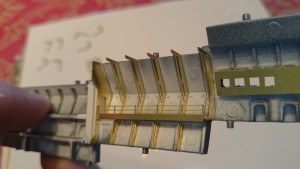
You can see even at this early stage how much PE adds to a kit like this – this is going to look stunning.
USS Enterprise Build Log – Part 2 USS Enterprise Build Log – Part 4


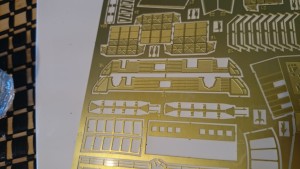
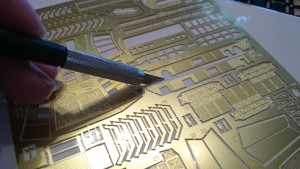
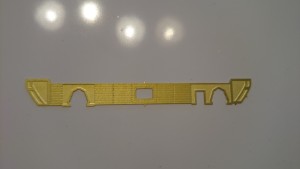

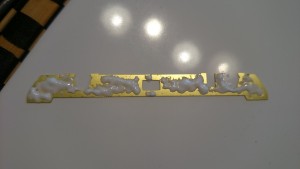
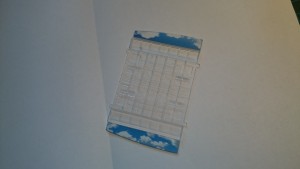
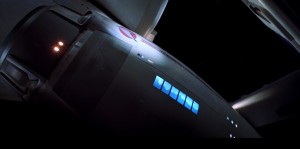
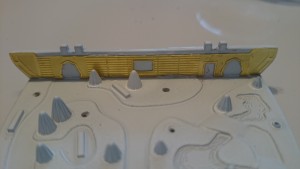
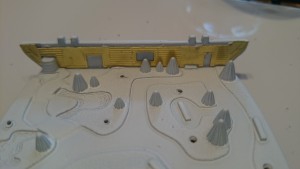
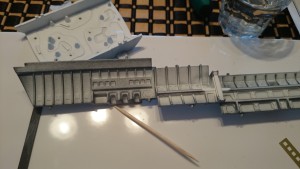
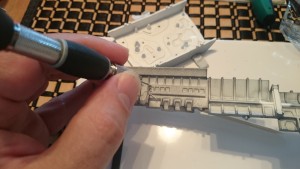
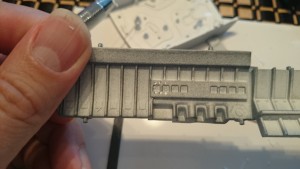
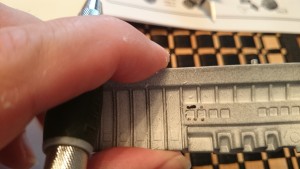

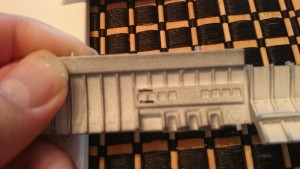

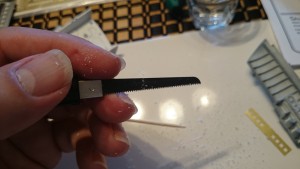
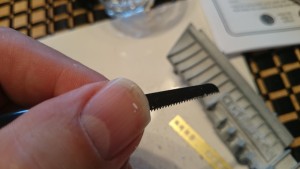

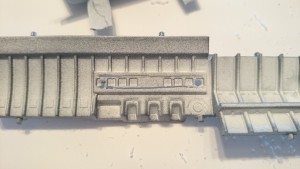

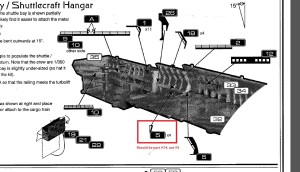
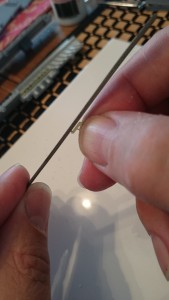
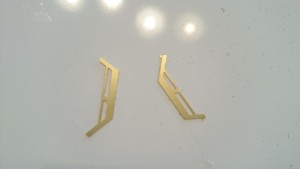
Pingback: The USS Enterprise (Refit) from Star Trek: The Motion Picture | Borked Code
Pingback: The USS Enterprise (Refit) from Star Trek: The Motion Picture | Borked Code